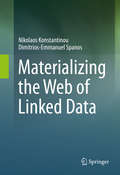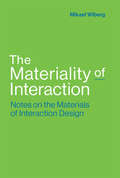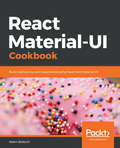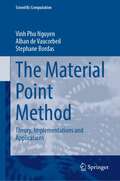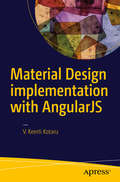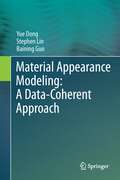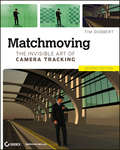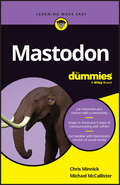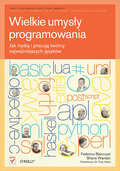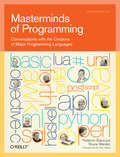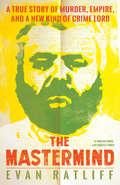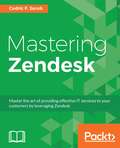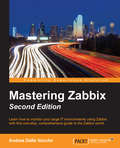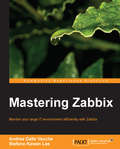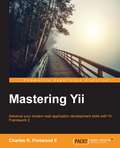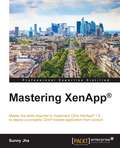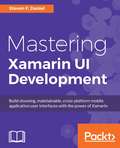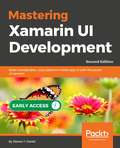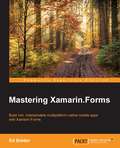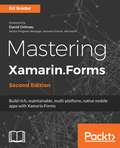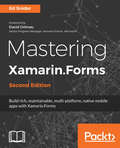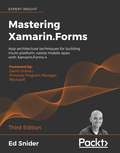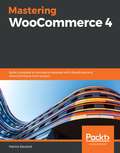- Table View
- List View
Materializing the Web of Linked Data
by Nikolaos Konstantinou Dimitrios-Emmanuel SpanosThis book explains the Linked Data domain by adopting a bottom-up approach: it introduces the fundamental Semantic Web technologies and building blocks, which are then combined into methodologies and end-to-end examples for publishing datasets as Linked Data, and use cases that harness scholarly information and sensor data. It presents how Linked Data is used for web-scale data integration, information management and search. Special emphasis is given to the publication of Linked Data from relational databases as well as from real-time sensor data streams. The authors also trace the transformation from the document-based World Wide Web into a Web of Data. Materializing the Web of Linked Data is addressed to researchers and professionals studying software technologies, tools and approaches that drive the Linked Data ecosystem, and the Web in general.
Materiality, Rules and Regulation: New Trends in Management and Organization Studies (Technology, Work and Globalization)
by Nathalie Mitev François-Xavier de Vaujany Anouk Mukherjee Giovan LanzaraMateriality, Rules and Regulation: New Trend in Management and Organization Studies concentrates on the relationship of rules and regulation to the materiality of artefacts, practices, and organizations. It combines the recent scholarly interest on sociomateriality with a focus on regulation and rules.
The Materiality of Interaction: Notes on the Materials of Interaction Design (The\mit Press Ser.)
by Mikael WibergA new approach to interaction design that moves beyond representation and metaphor to focus on the material manifestations of interaction.Smart watches, smart cars, the Internet of things, 3D printing: all signal a trend toward combining digital and analog materials in design. Interaction with these new hybrid forms is increasingly mediated through physical materials, and therefore interaction design is increasingly a material concern. In this book, Mikael Wiberg describes the shift in interaction design toward material interactions. He argues that the “material turn” in human-computer interaction has moved beyond a representation-driven paradigm, and he proposes “material-centered interaction design” as a new approach to interaction design and its materials. He calls for interaction design to abandon its narrow focus on what the computer can do and embrace a broader view of interaction design as a practice of imagining and designing interaction through material manifestations. A material-centered approach to interaction design enables a fundamental design method for working across digital, physical, and even immaterial materials in interaction design projects.Wiberg looks at the history of material configurations in computing and traces the shift from metaphors in the design of graphical user interfaces to materiality in tangible user interfaces. He examines interaction through a material lens; suggests a new method and foundation for interaction design that accepts the digital as a design material and focuses on interaction itself as the form being designed; considers design across substrates; introduces the idea of “interactive compositions”; and argues that the focus on materiality transcends any distinction between the physical and digital.
Materiality and Time
by Francois-Xavier de Vaujany Nathalie Mitev Pierre Laniray Emmanuelle VaastSociomaterial research overcomes the dichotomy between social and material worlds by concentrating on organizational practices. These practices are constituted by, but also produce, material and social dynamics. This research is currently having an important impact in management studies and adopts a subjective investigation of time to explore materiality and materialization. Studying the institutional evolution of an organization implies long time spans and it is shown more clearly through the inclusion of material traces of past actions. Materiality and Time is split into three parts: Part I explores how time is materialized and performed in organizations, i. e. how artefacts and material space perform time and temporal dynamics in organizations. Part II examines how organizations and organizational members are constituted by and constitutive of material artefacts. Part III reflects on what a historical perspective on these materializations can bring to the study of organizations. Contributions focus on the materialization of time and the material dynamic of organizations.
Material UI Cookbook: Build Captivating User Experiences Using React And Material-ui
by Adam BoduchThey are JavaScript developers who have some basic knowledge of React and would want to implement Material Design principles in React applications using Material UI. The reader wants to build a user interface using React components but doesn’t want to invent their own style or UX framework.
The Material Point Method: Theory, Implementations and Applications (Scientific Computation)
by Vinh Phu Nguyen Alban de Vaucorbeil Stephane BordasThis book provides an introduction to the fundamental theory, practical implementation, and core and emerging applications of the material point method (MPM) and its variants. The MPM combines the advantages of both finite element analysis (FEM) and meshless/meshfree methods (MMs) by representing the material by a set of particles overlaid on a background mesh that serves as a computational scratchpad.The book shows how MPM allows a robust, accurate, and efficient simulation of a wide variety of material behaviors without requiring overly complex implementations. MPM and its variants have been shown to be successful in simulating a large number of high deformation and complicated engineering problems such as densification of foam, sea ice dynamics, landslides, and energetic device explosions, to name a few, and have recently found applications in the movie industry. It is hoped that this comprehensive exposition on MPM variants and their applications will not only provide an opportunity to re-examine previous contributions, but also to re-organize them in a coherent fashion and in anticipation of new advances.Sample algorithms for the solutions of benchmark problems are provided online so that researchers and graduate students can modify these algorithms and develop their own solution algorithms for specific problems. The goal of this book is to provide students and researchers with a theoretical and practical knowledge of the material point method to analyze engineering problems, and it may help initiate and promote further in-depth studies on the subjects discussed.
Material Design implementation with AngularJS
by V. Keerti KotaruBuild high-quality web and mobile user interfaces (UI) that are interactive, fluid, and provide a consistent experience across devices from desktops to tablets to smartphones. Use a Material Design approach to position elements and create animations along with principles of the sophisticated AngularJS JavaScript framework. Take advantage of Angular Material, a UI component framework that works out of the box to design web pages that adapt to various screen sizes and adhere to Material Design specifications. What You Will Learn: Develop a UI that adheres to Material Design principles using Angular Material, a UI component framework Use various Angular Material elements, directives, and services in conjunction with CSS3 Flexbox for layout management Use best practice design techniques to develop a responsive UI to fit multiple devices and screen sizes from desktop to tablet to mobile phone Develop web apps for both mobile and desktop form factors and screen sizes using HTML, CSS, and JavaScript Who This Book Is For: Web and mobile app developers with a basic understanding of JavaScript, HTML, and CSS
Material Appearance Modeling: A Data-Coherent Approach
by Baining Guo Yue Dong Stephen LinA principal aim of computer graphics is to generate images that look as real as photographs. Realistic computer graphics imagery has however proven to be quite challenging to produce, since the appearance of materials arises from complicated physical processes that are difficult to analytically model and simulate, and image-based modeling of real material samples is often impractical due to the high-dimensional space of appearance data that needs to be acquired. This book presents a general framework based on the inherent coherency in the appearance data of materials to make image-based appearance modeling more tractable. We observe that this coherence manifests itself as low-dimensional structure in the appearance data, and by identifying this structure we can take advantage of it to simplify the major processes in the appearance modeling pipeline. This framework consists of two key components, namely the coherence structure and the accompanying reconstruction method to fully recover the low-dimensional appearance data from sparse measurements. Our investigation of appearance coherency has led to three major forms of low-dimensional coherence structure and three types of coherency-based reconstruction upon which our framework is built. This coherence-based approach can be comprehensively applied to all the major elements of image-based appearance modeling, from data acquisition of real material samples to user-assisted modeling from a photograph, from synthesis of volumes to editing of material properties, and from efficient rendering algorithms to physical fabrication of objects. In this book we present several techniques built on this coherency framework to handle various appearance modeling tasks both for surface reflections and subsurface scattering, the two primary physical components that generate material appearance. We believe that coherency-based appearance modeling will make it easier and more feasible for practitioners to bring computer graphics imagery to life. This book is aimed towards readers with an interest in computer graphics. In particular, researchers, practitioners and students will benefit from this book by learning about the underlying coherence in appearance structure and how it can be utilized to improve appearance modeling. The specific techniques presented in our manuscript can be of value to anyone who wishes to elevate the realism of their computer graphics imagery. For understanding this book, an elementary background in computer graphics is assumed, such as from an introductory college course or from practical experience with computer graphics.
Matchmoving
by Tim DobbertGet your foot in the studio door by learning the art of matchmovingMatchmoving is a technique that allows computer graphics to be inserted into live-action footage with correct position, scale, orientation, and motion. Also known as motion tracking, it's what allows movie monsters to run down Main Street and robots to run through crowds--and look real. Now this unique book from a top expert from Industrial Light and Magic teaches you the art of matchmoving.With step-by-step tutorials and pages of examples, this book first explains the basics and then shows you professional techniques, from 3D calibration and tracking, to stereoscopy, and more.Explains concepts and teaches professional techniques for successful matchmoving Authored by a top matchmove specialist from Industrial Light and Magic, who walks you through step-by-step tutorials and impressive examples Covers matchmoving basics, 2D tracking, 3D calibration and tracking, automatic tracking, cameras, integrating matchmoves, and stereoscopyLearn how studio visual effects professionals make all the right matchmoves with Matchmoving: The Invisible Art of Camera Tracking 2nd Edition.
Mastodon For Dummies
by Chris Minnick Michael McCallisterA little birdy told us you needed to know more about Mastodon Ready to escape the drama of existing social media platforms and try something new and awesome in the world of social media? In Mastodon For Dummies, experienced tech trainers Chris Minnick and Mike McCallister show you exactly how to use Mastodon, the hot decentralized social media offering on the web and destination for thousands of social media migrants. Learn how to sign up for the service on your choice of server and get familiar with the rules of what’s sure to become your new favorite app. You’ll discover how to connect with other people, attract your own followers, and make yourself right at home in the Mastodon community. In the book, you’ll find: Easy-to-follow instructions on how to choose the Mastodon server that suits you best Instructions for establishing new connections on a new social platform and learning the rules of the road Tips for conducting business on Mastodon and making a home for your home-based business or brand on the social media service Step-by-step guides on launching your very own serverIf you’re ready to leave old social platforms in the rear-view and try something new, grab a copy of Mastodon For Dummies.
Masterminds of Programming. Conversations with the Creators of Major Programming Languages
by Federico Biancuzzi i Chromatic<p>Droga od pomys?u do gotowej aplikacji jest d?uga i kr?ta. Najprawdopodobniej jednym z najd?u?szych jej odcinków jest ten po?wi?cony na programowanie. Sztab ludzi, wiele j?zyków ...</p>
Masterminds of Programming: Conversations with the Creators of Major Programming Languages (Theory in Practice (O'Reilly))
by Chromatic Federico BiancuzziMasterminds of Programming features exclusive interviews with the creators of several historic and highly influential programming languages. In this unique collection, you'll learn about the processes that led to specific design decisions, including the goals they had in mind, the trade-offs they had to make, and how their experiences have left an impact on programming today. Masterminds of Programming includes individual interviews with: Adin D. Falkoff: APL Thomas E. Kurtz: BASIC Charles H. Moore: FORTH Robin Milner: ML Donald D. Chamberlin: SQL Alfred Aho, Peter Weinberger, and Brian Kernighan: AWK Charles Geschke and John Warnock: PostScript Bjarne Stroustrup: C++ Bertrand Meyer: Eiffel Brad Cox and Tom Love: Objective-C Larry Wall: Perl Simon Peyton Jones, Paul Hudak, Philip Wadler, and John Hughes: Haskell Guido van Rossum: Python Luiz Henrique de Figueiredo and Roberto Ierusalimschy: Lua James Gosling: Java Grady Booch, Ivar Jacobson, and James Rumbaugh: UML Anders Hejlsberg: Delphi inventor and lead developer of C# If you're interested in the people whose vision and hard work helped shape the computer industry, you'll find Masterminds of Programming fascinating.
The Mastermind: Drugs. Empire. Murder. Betrayal.
by Evan RatliffThe incredible true story of the decade-long quest to bring down Paul Le Roux—the creator of a frighteningly powerful Internet-enabled cartel who merged the ruthlessness of a drug lord with the technological savvy of a Silicon Valley entrepreneur“Evan Ratliff has pried open a hidden world of high-tech gangsters and drug kingpins and double-crossers and stone-cold hitmen.”—David Grann, author of Killers of the Flower Moon It all started as an online prescription drug network, supplying hundreds of millions of dollars’ worth of painkillers to American customers. It would not stop there. Before long, the business had turned into a sprawling multinational conglomerate engaged in almost every conceivable aspect of criminal mayhem. Yachts carrying $100 million in cocaine. Safe houses in Hong Kong filled with gold bars. Shipments of methamphetamine from North Korea. Weapons deals with Iran. Mercenary armies in Somalia. Teams of hit men in the Philippines. Encryption programs so advanced that the government could not break them. The man behind it all, pulling the strings from a laptop in Manila, was Paul Calder Le Roux—a reclusive programmer turned criminal genius who could only exist in the networked world of the twenty-first century, and the kind of self-made crime boss that American law enforcement had never imagined. For half a decade, DEA agents played a global game of cat-and-mouse with Le Roux as he left terror and chaos in his wake. Each time they came close, he would slip away. It would take relentless investigative work, and a shocking betrayal from within his organization, to catch him. And when he was finally caught, the story turned again, as Le Roux struck a deal to bring down his own organization and the people he had once employed. Award-winning investigative journalist Evan Ratliff spent four years piecing together this intricate puzzle, chasing Le Roux’s empire and his shadowy henchmen around the world, conducting hundreds of interviews and uncovering thousands of documents. The result is a riveting, unprecedented account of a crime boss built by and for the digital age.Advance praise for The Mastermind“A true crime classic”—Publishers Weekly (starred review) “If truth is stranger than fiction, then The Mastermind is the truest book you’ll read this year. The only thing predictable about it is how quickly you’ll turn the pages.”—Noah Hawley, author of Before the Fall and creator of the TV series Fargo
Mastering Zendesk
by Cedric F. JacobThis book is for proficient Zendesk administrators who want to unlock the full potential of their Zendesk environment by gaining a deeper understanding of Zendesk’s advanced customization options.
Mastering Zabbix - Second Edition
by Andrea Dalle VaccheLearn how to monitor your large IT environments using Zabbix with this one-stop, comprehensive guide to the Zabbix world About This Book * Create a tailor-made monitoring solution based on your specific needs * Learn advanced techniques of Zabbix to monitor networks, performances, and other critical features in large environments * Integrate, customize, and extend your monitoring solutions with external components and software Who This Book Is For This book is intended for system administrators and IT architects who need to better integrate their Zabbix installation with their surrounding environment. A basic, working knowledge of Zabbix and Linux is assumed so that the book can focus on how to use every component to its full advantage. It will also be helpful to be familiar with programming concepts and languages but if not, all the content in the book is thorough and well documented. What You Will Learn * Efficiently collect data from a large variety of monitoring objects * Organize your data in graphs, charts, maps, and slide shows * Build intelligent triggers and alarms to monitor your network proactively * Write your own custom probes and monitoring scripts to extend Zabbix * Configure Zabbix and its database to be high available and fault-tolerant * Automate repetitive procedures using Zabbix's API * Integrate Zabbix with external systems * Understand the protocol and how to interact with it by writing your own custom agent In Detail Nowadays monitoring systems play a crucial role in any IT environment. They are extensively used to not only measure your system's performance, but also to forecast capacity issues. This is where Zabbix, one of the most popular monitoring solutions for networks and applications, comes into the picture. With an efficient monitoring system in place you'll be able to foresee when your infrastructure runs under capacity and react accordingly. Due to the critical role a monitoring system plays, it is fundamental to implement it in the best way from its initial setup. This avoids misleading, confusing, or, even worse, false alarms which can disrupt an efficient and healthy IT department. This new edition will provide you with all the knowledge you need to make strategic and practical decisions about the Zabbix monitoring system. The setup you'll do with this book will fit your environment and monitoring needs like a glove. You will be guided through the initial steps of choosing the correct size and configuration for your system, to what to monitor and how to implement your own custom monitoring component. Exporting and integrating your data with other systems is also covered. By the end of this book, you will have a tailor-made and well configured monitoring system and will understand with absolute clarity how crucial it is to your IT environment. Style and approach This book is an easy to follow, step-by-step guide to monitoring network and performance in large environments with Zabbix. It is designed for real-world Zabbix administrators, and is comprised of a perfect mix of theoretical explanations and practical applications, making it your perfect companion.
Mastering Zabbix
by Stefano Kewan Lee Andrea Dalle VaccheWritten as a practical step-by-step tutorial, this book is full of engaging examples to help you learn in a practical context.If you are a system administrator or an IT architect and want to know how to better integrate your Zabbix installation with your surrounding environment, this book is ideal for you. A basic, working knowledge of Zabbix is assumed, so that the book can focus on how to take full advantage of every component. The code in the later chapter will be explained in its functionality, but basic programming skills are assumed as well.
Mastering Yii
by Charles R. Portwood IIAdvance your modern web application development skills with Yii Framework 2 About This Book * Learn to work with the key aspects of Yii Framework 2 * Explore how to create RESTful APIs with Yii * Incorporate codeception with Yii2 to test your code thoroughly Who This Book Is For This book is for Yii Framework developers who want to quickly master Yii2. This book assumes some familiarity with Yii2, PHP 5, and HTML5. What You Will Learn * Explore Yii2's conventions and learn how to properly configure Yii2 * Create both web and console applications * Reduce development time by learning to create classes automatically with Gii, Yii2's automatic code generation tool * Use Yii2's database migration tool * Manage and access databases with Active Record, DAO, and Query Builder * Handle user authentication and authorization within Yii2 * Create RESTful APIs with Yii Framework 2 * Test applications automatically with codeception In Detail The successor of Yii Framework 1.1, Yii2 is a complete rewrite of Yii Framework, one of the most popular PHP 5 frameworks for making modern web applications. The update embraces the best practices and protocols established with newer versions of PHP, while still maintaining the simple, fast, and extendable behavior found in its predecessor. This book has been written to enhance your skills and knowledge with Yii Framework 2. Starting with configuration and how to initialize new projects, you'll learn how to configure, manage, and use every aspect of Yii2 from Gii, DAO, Query Builder, Active Record, and migrations, to asset manager. You'll also discover how to automatically test your code using codeception. With this book by your side, you'll have all the skills you need to quickly create rich modern web and console applications with Yii2. Style and approach This book is a step-by-step guide to mastering every aspect of Yii Framework 2. Each chapter outlines a new set of tools along with code that can be used to efficiently create modern web and console applications
Mastering XenApp®
by Sunny JhaMaster the skills required to implement Citrix® XenApp® 7.6 to deploy a complete Citrix®-hosted application from scratch About This Book * Learn to implement and configure components of Citrix® XenApp® 7.6, which are XenServer®, XenApp®, Citrix® License server, PVS, Storefront, Citrix® Receiver, and Netscaler to secure WAN traffic * Build the XenApp® 7.6 environment independently and perform tests to make sure the components are working as expected for internal and external traffic * Implement advanced tools in Citrix® XenApp® to build and manage a cost effective, secure, and high-performing application delivery infrastructure with this comprehensive guide Who This Book Is For This is book is for administrators who are currently managing the implemented environment and want to learn how to deploy the Citrix® Hosted virtualization solution for the application in a windows server 2012 R2 environment. A reasonable knowledge and understanding of core XenApp® elements and concepts used during virtualizing applications are assumed. What You Will Learn * Understand how to set up Hypervisor, install the management console, configure the storage repository, and create a virtual machine on hypervisor * Set up an Infrastructure component and explore ways to tune them up so that they can be used for Citrix® environment * Set up a Domain controller, DHCP, Certificate authority, and SQL server for static database for Citrix® XenApp® * Validate the Citrix® XenApp® 7.6 solution to make sure components are communicating properly * Manage the essential Citrix® components - Director, Licensing, and Policies with the Help of Citrix® studio * Optimize the behavior of an Application and share desktop via Policies * Installing and configuring Citrix® Provisioning services to deliver Citrix® XenApp® 7.6 virtual machines * Secure the external Delivery of an application and shared desktop via netscaler to enjoy mobility In Detail Citrix® XenApp® is one of the leading pieces of Application delivery software that delivers Windows compatible apps to users on any device, anywhere. Citrix® XenApp® also gives administrators the ability to manage and control the freedom of mobility by increasing the security and saving costs at the same time. This book will provide you with all the knowledge required to successfully deploy and master a complete Citrix® hosted application. First, it will cover essential concepts of the architecture of XenApp®. You will then learn how to set up Hypervisor and how to set up Infrastructure components. Next you will learn how to Set up Citrix® Components, XenApp® resources, PVS, and Netscaler. We will further look at how to prepare the environment for Rollout. Additionally, you will learn how to configure the Citrix® components such as Citrix® Director. Moreover, you'll learn about shared desktop for delivery to end users and the application of policies for effective and secure delivery. Finally, you will learn how to implement provisioning services for a Citrix® XenApp® 7.6 environment. Style and approach This book is based on a course outline and hence takes a very practical approach so you will understand how to implement the components of XenApp® in a production environment. Complemented with many best practices and troubleshooting concepts of XenApp®, this book will help you master XenApp® swiftly.
Mastering Xamarin UI Development
by Steven F. DanielBuild stunning, maintainable, cross-platform mobile application user interfaces with the power of Xamarin About This Book • Create, configure, and customize stunning platform-specific features as well as cross-platform UIs with the power of Xamarin Forms. • Maximize the testability, flexibility, and overall quality of your Xamarin apps. • Get the most out of Xamarin.Forms and create your own reusable templates with C# scripting in Xamarin. Who This Book Is For If you are a mobile developer with basic knowledge of Xamarin and C# coding, then this book is for you. What You Will Learn • Develop stunning native cross-platform apps using the Xamarin.Forms framework • Work with the different UI layouts to create customized layouts using the C# programming language and tweak it for a given platform • Customize the user interface using DataTemplates and CustomRenderers and the Platform Effects API to change the appearance of control elements • Build hybrid apps using the Razor Template Engine and create Razor Models that communicate with a SQLite database • Use location based features within your app to display the user's current location • Work with the Xamarin.Forms Map control to display Pin placeholders based on the stored latitude and longitude coordinates • Understand and use the MVVM pattern architecture to navigate between each of your ViewModels and implement Data Binding to display and update information • Work with the Microsoft Azure Platform to incorporate API Data Access using Microsoft Azure App Services and the RESTful API • Incorporate third-party features within your app using the Facebook SDK and the Open Graph API • Perform unit testing and profile your Xamarin.Forms applications • Deploy your apps to the Google Play Store and Apple App Store In Detail Xamarin is the most powerful cross-platform mobile development framework. If you are interested in creating stunning user interfaces for the iOS and Android mobile platforms using the power of Xamarin and Xamarin.Forms, then this is your ticket. This book will provide you the practical skills required to develop real-world Xamarin applications. You will learn how to implement UI structures and layouts, create customized elements, and write C# scripts to customize layouts. You will create UI layouts from scratch so that you can tweak and customize a given UI layout to suit your needs by using Data Templates. Moving on, you will use third-party libraries – such as the Razor template engine that allows you to create your own HTML5 templates within the Xamarin environment – to build a book library Hybrid solution that uses the SQLite.Net library to store, update, retrieve, and delete information within a SQLite local database. You'll also implement key data-binding techniques that will make your user interfaces dynamic, and create personalized animations and visual effects within your user interfaces using Custom Renderers and the PlatformEffects API to customize and change the appearance of control elements. At the end of this book, you will test your application UI for robust and consistent behavior and then explore techniques to deploy to different platforms. Style and approach This easy to follow guide will walk you through building a real world Xamarin.Forms mobile app from start to finish. Each chapter builds upon the app using a step-by-step methodology that applies new advanced functionalities, design patterns, and best practices.
Mastering Xamarin UI Development: Build robust and a maintainable cross-platform mobile UI with Xamarin and C# 7, 2nd Edition
by Steven F. DanielLearn how to build stunning, maintainable, cross-platform mobile application user interfaces using C# 7 with the power of both the Xamarin and Xamarin.Forms frameworks.Key FeaturesBuild effective native and cross-platform user interfaces using the Xamarin frameworks for iOS and Android, as well as Xamarin.Forms.Maximize the testability, flexibility, and overall quality of your Xamarin mobile apps.Step-by-Steps guide that is packed with real-world scenarios and solutions, to build professional grade mobile apps and games for the iOS and Android platforms, using C# 7.Book DescriptionThis book will provide you with the knowledge and practical skills that are required to develop real-world Xamarin and Xamarin.Forms applications. You’ll learn how to create native Android app that will interact with the device camera and photo gallery, and then create a native iOS sliding tiles game. You will learn how to implement complex UI layouts and creating customizable control elements based on the platform, using XAML and C# 7 code to interact with control elements within your XAML ContentPages.You’ll learn how to add location-based features by to your apps by creating a LocationService class and using the Xam.Plugin.Geolocator cross-platform library, that will be used to obtain the current device location. Next, you’ll learn how to work with and implement animations and visual effects within your UI using the PlatformEffects API, using C# code.At the end of this book, you’ll learn how to integrate Microsoft Azure App Services and use the Twitter APIs within your app. You will work with the Razor Templating Engine to build a book library HTML5 solution that will use a SQLite.net library to store, update, retrieve, and delete information within a local SQLite database. Finally, you will learn how to write unit tests using the NUnit and UITest frameworks.What you will learnBuild native and cross-platform apps for both iOS and Android using the Xamarin and Xamarin.Forms platform using C# 7. Implement and customize different user-interface layouts and Animations within your application and use the PlatFormEffects API to change appearance of control elements.Understand the MVVM architectural pattern and how to implement this with your apps.Build a NavigationService class to enable. navigation between your ViewModels as well as Implementing Data-Binding to control elements within your XAML pages and ViewModels.Work with the Razor Templating Engine to create Models and Razor Pages that communicate with an SQLite database.Build a LocationService class to incorporate location-based features within your cross-platform apps to display the user’s current location by creating a custom cross-platform map control and handle location tracking updates.Work with the Microsoft Azure App Services Platform and Implement Social networking features within your app using the Twitter API.Unit Testing your Xamarin.Forms apps using the NUnit and UITest FrameworksWho this book is forThis book is intended for readers who have experience using at least the C# 6.0 programming language and interested in learning how to create stunning native, and cross-platform user interfaces for the iOS and Android platforms using the Xamarin and Xamarin.Forms frameworks using C# 7.
Mastering Xamarin.Forms
by Ed SniderBuild rich, maintainable multiplatform native mobile apps with Xamarin.Forms About This Book * Build an effective mobile app architecture with the Xamarin.Forms toolkit * Maximize the testability, flexibility, and overall quality of your Xamarin.Forms mobile app * This step-by-step tutorial is packed with real-world scenarios and solutions to build professional grade mobile apps with Xamarin.Forms Who This Book Is For This book is intended for C# developers who are familiar with the Xamarin platform and the Xamarin.Forms toolkit. If you have already started working with Xamarin.Forms and want to take your app to the next level and make it more maintainable, testable, and flexible, then this book is for you. What You Will Learn * Find out how, when, and why you should use architecture patterns and get best practices with Xamarin.Forms * Implement the Model-View-ViewModel (MVVM) pattern and data-binding in Xamarin.Forms mobile apps * Extend the Xamarin.Forms navigation API with a custom ViewModel-centric navigation service * Leverage the inversion of control and dependency injection patterns in Xamarin.Forms mobile apps * Work with online and offline data in Xamarin.Forms mobile apps * Test both business logic and user interface code in Xamarin.Forms mobile apps * Use platform-specific APIs to build rich custom user interfaces in Xamarin.Forms mobile apps * Explore how to improve mobile app quality with analytics and crash reporting using Xamarin Insights In Detail Discover how to extend and build upon the components of the Xamarin.Forms toolkit to develop an effective, robust mobile app architecture. Starting with an app built with the basics of the Xamarin.Forms toolkit, we'll go step by step through several advanced topics to create a solution architecture rich with the benefits of good design patterns and best practices. We'll start by introducing a core separation between the app's user interface and the app's business logic by applying the MVVM pattern and data binding. Discover how to extend and build upon the components of the Xamarin.Forms toolkit to develop an effective, robust mobile app architecture. Starting with an app built with the basics of the Xamarin.Forms toolkit, we'll go step by step through several advanced topics to create a solution architecture rich with the benefits of good design patterns and best practices. We'll start by introducing a core separation between the app's user interface and the app's business logic by applying the MVVM pattern and data binding. Then we will focus on building out a layer of plugin-like services that handle platform-specific utilities such as navigation, geo-location, and the camera, as well as how to use these services with inversion of control and dependency injection. Next we'll connect the app to a live web-based API and set up offline synchronization. Then, we'll dive into testing the app--both the app logic through unit tests and the user interface using Xamarin's UITest framework. Finally, we'll integrate Xamarin Insights for monitoring usage and bugs to gain a proactive edge on app quality. Style and approach This easy-to-follow, code-rich guide will walk you through building a real-world Xamarin.Forms mobile app from start to finish. Each chapter builds upon the app by applying new advanced functionalities, design patterns, and best practices.
Mastering Xamarin.Forms.: Build Rich, Maintainable, Multi-platform, Native Mobile Apps With Xamarin. Forms
by Ed SniderDiscover how to extend and build upon the components of the Xamarin.Forms toolkit to develop an effective, robust mobile app architecture. Starting with an app built with the basics of the Xamarin.Forms toolkit, you'll go step by step through several advanced topics to create a solution architecture rich with the benefits of good design patterns and best practices.
Mastering Xamarin.Forms: Build rich, maintainable, multi-platform, native mobile apps with Xamarin.Forms, 2nd Edition
by Ed SniderCreate high-quality multi-platform native apps with Xamarin.FormsKey Features Packed with real-world scenarios and solutions to help you build professional-grade mobile apps with Xamarin.Forms Build an effective mobile app architecture with the Xamarin.Forms toolkit Find out how, when, and why you should use architectural patterns and get best practices with Xamarin.FormsBook DescriptionDiscover how to extend and build upon the components of the Xamarin.Forms toolkit to develop an effective, robust mobile app architecture. Starting with an app built with the basics of the Xamarin.Forms toolkit, you'll go step by step through several advanced topics to create a solution architecture rich with the benefits of good design patterns and best practices. You'll start by introducing a core separation between the app's user interface and its business logic by applying the MVVM pattern and data-binding. Then you focus on building out a layer of plugin-like services that handle platform-specific utilities such as navigation and geo-location, and on how to loosely use these services in the app with inversion of control and dependency injection. Next you connect the app to a live web-based API and set up offline synchronization. Then, you delve into testing the app logic through unit tests. Finally, you set up Visual Studio App Center for monitoring usage and bugs to gain a proactive edge on app quality.What you will learn Implement the Model-View-View-Model (MVVM) pattern and data-binding in Xamarin.Forms mobile apps Extend the Xamarin.Forms navigation API with a custom ViewModel-centric navigation service Leverage the inversion of control and dependency injection patterns in Xamarin.Forms mobile apps Work with online and offline data in Xamarin.Forms mobile apps Test business logic in Xamarin.Forms mobile apps Use platform-specific APIs to build rich custom user interfaces in Xamarin.Forms mobile apps Explore how to improve mobile app quality using Visual Studio AppCenterWho this book is forThis book is intended for C# developers who are familiar with the Xamarin platform and the Xamarin.Forms toolkit. If you have already started working with Xamarin.Forms and want to take your app to the next level with higher quality, maintainability, testability, and flexibility, then this book is for you.
Mastering Xamarin.Forms: App architecture techniques for building multi-platform, native mobile apps with Xamarin.Forms 4, 3rd Edition
by Ed Snider David OrtinauNew edition of the bestselling guide to building an effective mobile app architecture with Xamarin.Forms 4 that maximizes the overall quality of apps. Key Features Updated for Xamarin.Forms 4 Packed with real-world scenarios and solutions to help you build professional grade mobile apps with Xamarin.Forms Includes design patterns and best practice techniques that every mobile developer should know Book Description Discover how to extend and build upon the components of the most recent version of Xamarin.Forms to develop an effective, robust mobile app architecture. This new edition features Xamarin.Forms 4 updates, including CollectionView and RefreshView, new coverage of client-side validation, and updates on how to implement user authentication. Mastering Xamarin.Forms, Third Edition is one of the few Xamarin books structured around the development of a simple app from start to finish, beginning with a basic Xamarin.Forms app and going step by step through several advanced topics to create a solution architecture rich with the benefits of good design patterns and best practices. This book introduces a core separation between the app's user interface and the app's business logic by applying the MVVM pattern and data binding, and then focuses on building a layer of plugin-like services that handle platform-specific utilities such as navigation and geo-location, as well as how to loosely use these services in the app with inversion of control and dependency injection. You'll connect the app to a live web-based API and set up offline synchronization before testing the app logic through unit testing. Finally, you will learn how to add monitoring to your Xamarin.Forms projects to track crashes and analytics and gain a proactive edge on quality. What you will learn Find out how, when, and why to use architecture patterns and best practices with Xamarin.Forms Implement the Model-View-ViewModel (MVVM) pattern and data binding in Xamarin.Forms mobile apps Incorporate client-side validation in Xamarin.Forms mobile apps Extend the Xamarin.Forms navigation API with a custom ViewModel-centric navigation service Leverage the inversion of control and dependency injection patterns in Xamarin.Forms mobile apps Work with online and offline data in Xamarin.Forms mobile apps Use platform-specific APIs to build rich custom user interfaces in Xamarin.Forms mobile apps Explore how to monitor mobile app quality using Visual Studio App Center Who this book is for This book is intended for .NET developers who are familiar with Xamarin mobile application development and the open source Xamarin.Forms toolkit. If you have already started working with Xamarin.Forms and want to take your app to the next level, making it more maintainable, testable and flexible, then this book is for you.
Mastering WooCommerce 4: Build complete e-commerce websites with WordPress and WooCommerce from scratch
by Patrick RaulandUnderstand all aspects of building a successful online store which is search-engine-optimized, using theme management and one-page checkout features Key Features Extend your WordPress knowledge to build fully functional e-commerce websites using WooCommerce and its plugins Implement payment gateway, shipping, and inventory management solutions Improve the speed and performance of your websites by optimizing images and caching static information Book Description WooCommerce is one of the most flexible platforms for building online stores. With its flexibility, you can offer virtually any feature to a client using the WordPress system. WooCommerce is also self-hosted, so the ownership of data lies with you and your client. This book starts with the essentials of building a WooCommerce store. You'll learn how to set up WooCommerce and implement payment, shipping, and tax options, as well as configure your product. The book also demonstrates ways to customize and manage your products by using SEO for enhanced visibility. As you advance, you'll understand how to manage sales by using POS systems, outsource fulfillment, and external reporting services. Once you've set up and organized your online store, you'll focus on improving the user experience of your e-commerce website. In addition to this, the book takes you through caching techniques to not only improve the speed and performance of your website but also its look and UI by adding themes. Finally, you'll build the landing page for your website to promote your product, and design WooCommerce plugins to customize the functionalities of your e-commerce website. By the end of this WooCommerce book, you'll have learned how to run a complete WooCommerce store, and be able to customize each section of the store on the frontend as well as backend. What you will learn Grasp the fundamentals of e-commerce website design and management with WordPress Use Gutenberg product blocks to display products across various categories on your website Get to grips with WordPress plugin development to customize your website's functionality Discover various ways to effectively handle product payment, taxes, and shipping Use analytics and product data syncing in WordPress to keep an eye on the user experience and monitor the performance of your online store Promote your new product online using SEO management and landing pages Who this book is for This WooCommerce development book is for web developers, WordPress developers, e-commerce consultants, or anyone familiar with using WordPress and interested in building an e-commerce platform from scratch. Working knowledge of WordPress development and general web development concepts is required.
